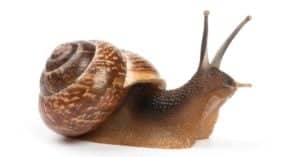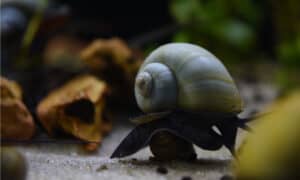People often mistake pond snails for bladder snails or the other way around. The thing is that both of them are a bit dangerous to be kept as pets since they can cause a snail infestation.
But when it comes to physical characteristics, it’s not so difficult to figure out which is which. If you keep snails as pets or if you’re a snail enthusiast, you’ve arrived at the right place! We’ll discuss a bit about both types of snails. Then, we’ll move on to some differences and similarities between the two. Your only job is to read and enjoy it!
Comparing Pond Snails vs Bladder Snails
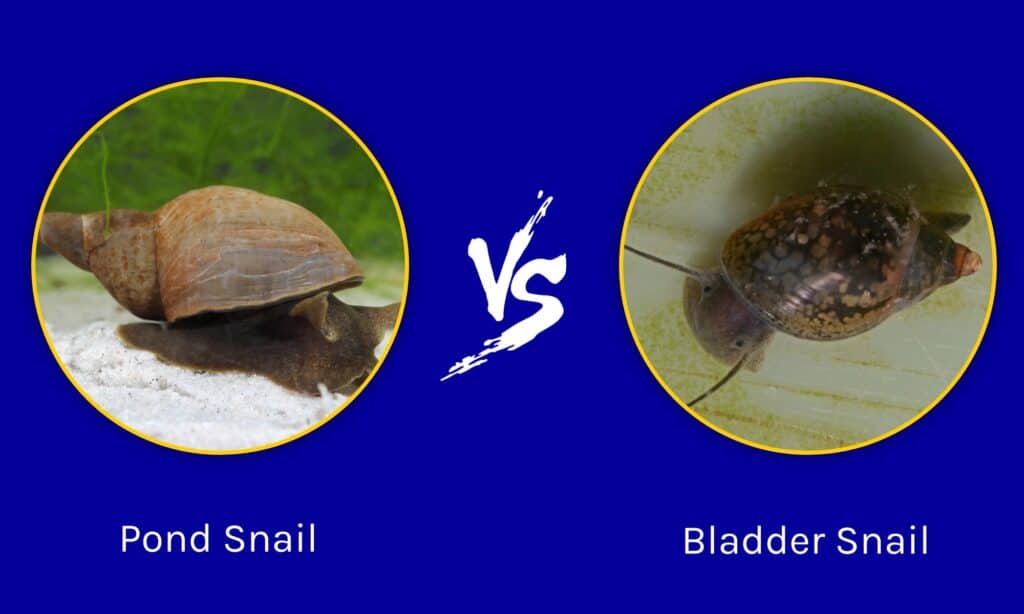
| Pond Snail | Bladder Snail | |
|---|---|---|
| Technical term | Family of snails | Family of snails |
| Size | 0.3-3 inches | 0.5-0.6 inches |
| Shell direction | Dextral (to the right) | Sinistral (to the left) |
| Colors | Grey, brown, green, black | Thin and translucent shell; yellow, gold |
| Diet | Omnivore | Omnivore |
| Tentacles | Triangular-shaped, thick | Short and thin |
| Lifespan | 1-3 year | 1-2 years |
The Key Differences Between Pond Snails and Bladder Snails
The key differences between pond snails and bladder snails are appearance, lifespan, and adaptability.
Both pond snails and bladder snails are families of freshwater snails.
Pond Snail is the common name for Lymnaeidae and is a taxonomic family of small to large species of snails. They are air-breathing freshwater snails. It’s the most common family of freshwater snails in the world. On the one hand, pet owners like pond snails because they’re extremely good at cleaning tanks of algae. On the other hand, they reproduce so quickly that they can cause overpopulation. So if you have some pond snails in your tank, don’t be surprised if you wake up with lots of eggs eager to populate the tank. Moreover, if you have other pets in the tank, they definitely won’t be too happy if you introduce a pond snail into their habitat!
Bladder Snail is the common name for Physidae and is a monophyletic taxonomic family of small snails. Just as pond snails, these are air-breathing freshwater snails in the superfamily of Lymnaeidae. They are also called pouch snails or tadpole snails. Bladder snails are common throughout the whole world, except for Antarctica. Like pond snails, bladder snails can be useful and damaging to your tank. They are great tank cleaners but reproduce extremely fast. Even more, they are considered an invasive species.
Pond Snail vs Bladder Snail: Color and Form
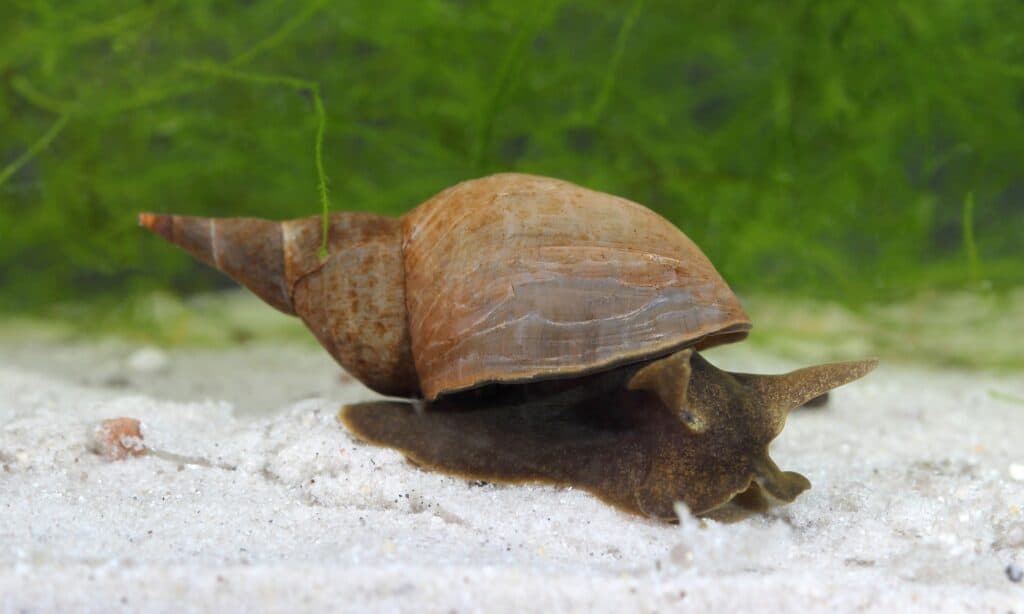
Pond snails can feature a variety of colors, with shades of gray, green, brown, or black.
©iStock.com/VitalisG
Pond snails can feature a variety of colors, with shades of gray, green, brown, or black. Some can have a yellowish-brown shade and tiny dark spots. Their shells consist of two to six weakly convex whorls—their spiral moves to the right. Pond snails have triangular-shaped tentacles. Unlike other snails, they don’t have an operculum to help them protect themselves.
Bladder snails have pale colors, such as yellowish or shades of gold. Some of them have spots on their shells. Their unique characteristic is the fact that their shells are translucent and thin. One can see the snail’s flesh through its shell. The mantle, on the other hand, is brighter, featuring orange spots. The shell has four to five whorls, and the spiral moves to the left. The bladder snail’s tentacles are thinner and shorter than the pond snail’s. Bladder snails don’t have an operculum.
Pond Snail vs Bladder Snail: Size
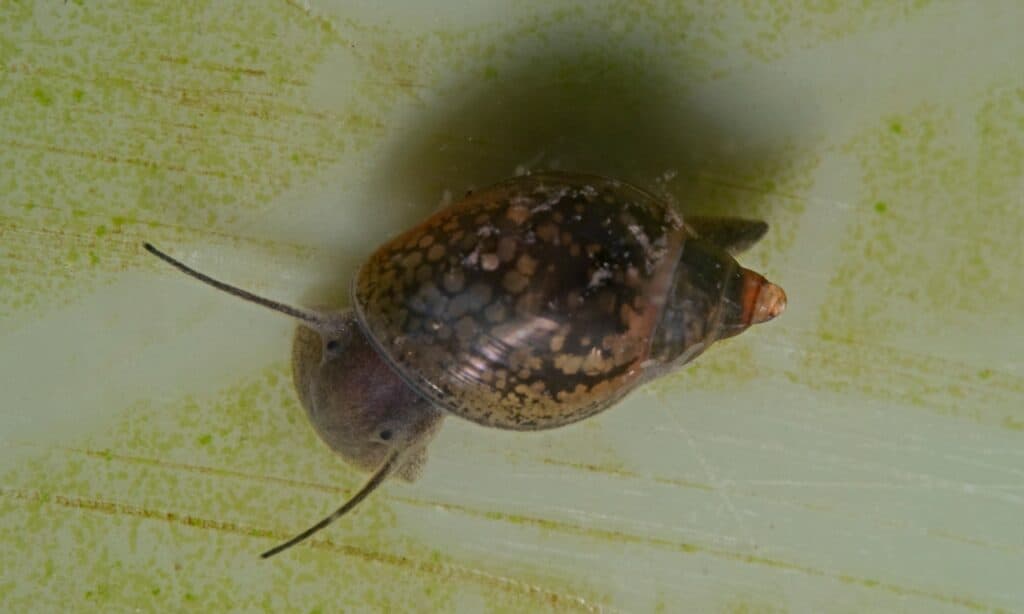
Bladder snails never grow past 0.6 inches.
©iStock.com/scubaluna
One important difference between pond snails and bladder snails is their size. Some pond snail species, such as the great pond snail or the big ear pond snail, can grow as large as 3 inches in diameter. Bladder snails never grow past 0.6 inches. In fact, they rarely go beyond 0.5 inches.
Pond Snail vs Bladder Snail: Lifespan

Pond snails can live up to 3 years.
©iStock.com/scubaluna
It’s considered that pond snails can live up to 3 years if taken good care of. Bladder snails can only live up to 2 years. In fact, not all snails reach this age, especially if the tank water is not adjusted to their needs.
If you’re worried your snail is sick, especially if it’s grown older, check out these tips on how to notice if there’s something wrong with it:
- Check to see if your snail is floating; some snails will float if they are weak; this does not necessarily indicate that it is sick, but you should keep an eye on it in case the situation worsens;
- Check to see if your snail is tip-toeing; snails usually do this when they’re old and are close to natural death;
- Check if your snail’s foot is swollen or discharging; various chemicals can cause this in the water, such as plant fertilizers or anything with copper; this is not a serious problem if caught early, all you have to do is change and clean the water;
- Mantle collapse means that the shell of the snail is partially or fully detached from the mantle; it’s a severe condition and can sometimes be fatal.
Pond Snail vs Bladder Snail: Adaptability
Bladder snails are more adaptable than pond snails. The latter likes its water stagnant and calm. Bladder snails can easily adapt to any kind of water.
The Similarities Between Pond Snails and Bladder Snails
Pond Snail vs Bladder Snail: Reproduction

Bladder snails, along with pond snails, are asexual invertebrates.
©scubaluna/Shutterstock.com
Pond snails and bladder snails are both asexual invertebrates. This means they can be both male and female and can self-fertilize if they don’t have a partner. Their sperm storage organ makes self-fertilization possible. They rely on this only if they can’t find a partner within six to eight weeks. That’s why it’s a bit dangerous to have them in a tank, as you can end up with dozens of new snails!
Pond Snail vs Bladder Snail: Food and infestation
Moreover, if you notice the number of snails growing bigger and bigger, this might mean that you’re feeding them too much or too often. Both pond snails and bladder snails will eat as much as you give them, and you’ll likely face a snail infestation as a result. In this case, you can opt for a snail-eating fish to control the infestation or use a lettuce trap. If you leave a leaf on the bottom of the tank, you’ll take it out full of snails after a few hours.
The photo featured at the top of this post is © scubaluna/Shutterstock.com
Thank you for reading! Have some feedback for us? Contact the AZ Animals editorial team.




